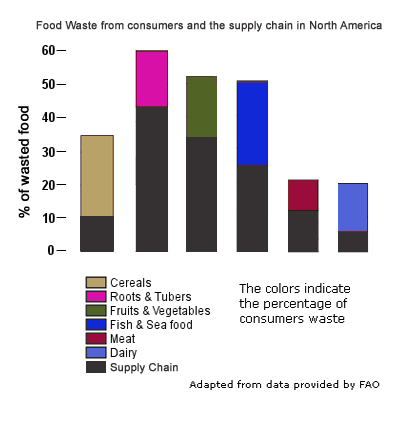By Guadalupe Astorga

More than 40% of the food in the United States ends up in the trash can. This is huge, and includes sea-food, meat, cereals fruits and vegetables, as well as dairy products. Surprisingly, the Food and Agriculture Organization (FAO) reports that for all categories, food waste is not primarily the result of a deficient food supply chain, but rather occurs at home (see graph). In industrialized countries food wastage by consumers is as high as the total net food production in the sub-Saharan African region. This reflects an irresponsible behavior, fruit of the occidental consumption culture. This situation is especially concerning for the case of marine resources, where half of the fish and seafood exploited is never eaten. If we consider the whole supply chain, North America wastes half of the fishery production. In a world with limited and over-exploited marine resources, this is unacceptable.

But consumers not only throw away the marine resources, we also waste cereal, fruit and vegetables, meat and dairy products (see graph). A similar situation is observed in Europe, where food wastage can reach up to 30%. It is interesting to compare this scenario with developing countries, where food wastage by consumers is negligible. Does it mean that in occidental countries with higher income levels people can afford to throw away food? Meanwhile, almost 800 million people suffer from severe hunger and malnutrition.
What can we do?
First of all, educate ourselves for more responsible food consumption habits.
A few weeks ago, members of the French parliament (MPs) unanimously voted to propose a law that will force supermarkets to give unsold food to charities, risking a fine of up to 102,000 dollars if they do not adhere. The initiative was driven by Arash Derambarsh, a municipal councilor that persuaded the French MPs to adopt the measure after his petition throw change.org obtained more than 200,000 signatures and celebrity support. He is planning to expand this initiative to Europe in the next few months, even though the law ignited debates about implementation of similar laws has already started in several other countries.
Several worldwide non-profit associations collect unsold food from supermarkets for free distribution among people with low income levels. An example of these associations in New York are City Harvest, Hunger Solutions New York, Food Bank for New York City, and The New York City Coalition Against Hunger.
An alternative movement of people known as freegans also contribute to this anti-waste culture as they rummage through the garbage of retailers, residences, offices, and other facilities for useful goods. The goods recovered by freegans are safe, usable and clean, reflecting how retailers dispose of a high volume of products in perfect condition.
Let’s now consider the environmental impact of food loss and waste. The worldwide carbon footprint of food produced and not eaten ranks third, after the USA and China. Thirty percent of available agricultural land is used to grow or farm food that will never be eaten.
In a growing population like ours, estimates from FAO suggest that food production should increase by at least 50% in the next 30 years in order to satisfy its alimentary requirements. If we reduce the food waste by a quarter, the whole world population could fulfill its alimentary necessities.
